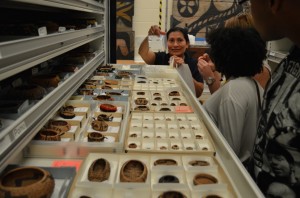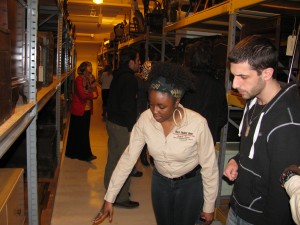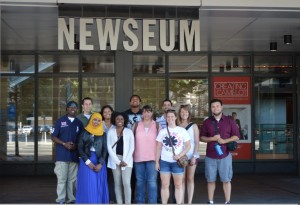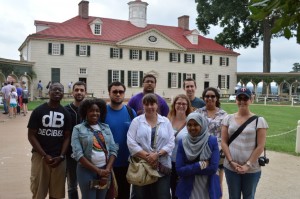Rethinking diversity: Chris Taylor, molding future public historians
04 December 2014 – Angela Thorpe
This is the third post in a series on issues of diversity in the public history field. Each post in this series is based upon oral interviews conducted with public history professionals. Each interview was conducted in a traditional interview question and answer format. All interviews were edited and condensed based on relevancy and to retain a reasonable length for the posts.
In developing this series, I sought out examples of public historians who are combating the diversity issue in creative and proactive ways. I looked for individuals who not only hoped to change the pool of future public historians but who employed tangible solutions that other museums and institutions could build on. One such individual is Chris Taylor, Diversity Outreach Program Manager at the Minnesota Historical Society (MHS).
Like many of the students he works with, Taylor took a nontraditional pathway to public history. His background in social sciences and education provided him with a unique opportunity to engage in the year-long Coca Cola Museum Fellows program, which exposed him to topics surrounding diversity and inclusion in museums. The experience inspired him to pursue a History Museum Studies graduate degree at the Cooperstown Graduate Program, which is led by pioneering African American museum professional Gretchen Sullivan Sorin. As a young museum professional, Taylor implemented a program at MHS modeled after the Coca Cola Museum Fellows program, and the MHS program has enjoyed nine years of success. In fact, the MHS Diversity Outreach Program was recently named the Diversity Outreach Department, making the society one of the only historical institutions in the United States to establish a permanent department focused solely on increasing its diversity and inclusion efforts.
AT: Why is this issue relevant?

2013 Fellows at National Museum of the American Indian, Cultural Resources Center, Suitland, MD. Photo credit: Chris Taylor
CT: If we don’t change the staff, we don’t change the voice of who is narrating the story. If we don’t have people of color having a seat at the table when decisions are made, and having a different perspective embedded into the fabric of what we do every day, we’re not going to be able to change dominant perceptions. It’s a necessity in my mind.
AT: Why are there so few individuals from diverse backgrounds practicing public history?
CT: First and foremost, if you look at the origins or foundations of museums, they were elite organizations. They didn’t make any kind of apologies for that. That’s who they were, that’s what they were aimed at. And that culture just stuck with museums. It’s definitely a culture of educated, mostly white, middle- to upper-middle class folks. And I think that leads to other reasons like, “if you don’t tell my story, if you don’t show that you value me in your marketing, in your programming, in your daily work, then I’m not going to patronize you. I’m not going to give you my money to come in and see the dominant historical narrative.” People of color aren’t going to make us real high on their priority list if we’re not making them high on ours.
And I think, too, when we look at hiring practices or the field of museums or the public history field, we’re always running up against requirements: you’ve got to have a BA, you’ve got to have a Master’s, you’ve got to have this, you’ve got to have that. And when you look at an education system that’s skewed towards the dominant culture, right away you’re shrinking the pool of diverse candidates. I think part of what we need to do if we’re looking at diversifying the field is we need to bring people in based on can they do a job or not?
When you look at socio-economic inequality, a lot of the undergraduate students that I work with, they’re chasing the money. They want to go into business or they want to be lawyers or doctors because they want to break that poverty cycle. We’re not a real attractive source financially. And with the education requirements, and the fact that we traditionally marginalize groups because of our institutionalism, I think those are the reasons we don’t see more diversity in the field.
AT: So there seems to be a pipeline issue. How can we grab people from other fields or let them know that there are ways to get into this field?
CT: MHS is very aggressive about it. I brought a program to MHS targeted at undergraduate students of color. We usually run a placement rate of about 75-80% students of color in the program. And they’re small. There’s usually between 12-15 students in each cohort. But we’ve got three different versions to cover fall semester, spring semester, and summer. And our summer program is strictly American Indian students because they have a whole different relationship with museums and the historical narrative and public history. But an underlying theme in all the different cohorts that we have–I like to tell them, if you don’t like the way someone is telling your story, you should come tell it yourself. Right? So if you are frustrated by how the public historical narrative portrays your story, or ignores your story, have a hand in shaping that.
So we’re hoping, slowly but surely, we’re trying to put a little more color into the museum field, but we made a conscious decision not to make the program exclusive. But I guarantee you everybody’s coming out of the program with a way different perspective on museums as far as museums’ social responsibility.
Taylor adds that, through study, internships, and engaging with theory, he gets people engaged to the point where they will have–and are prepared for–jobs.
AT: How do you recruit or attract your students? What draws them into your program?
CT: We’re wrapping up the 5th year of the very first version of the program. And right now that program is just getting it through word of mouth. We spend a lot of time with fraternities and sororities and student organizations and various professors in ethnic studies departments. I can remember in the first year of the program just handing out flyers to students of color I would randomly pass on campus. But now the reputation has built up to where we’re getting referrals. It’s not something on our website or a listserv because we’re going to get the overachieving college student that is probably going to be successful anyway. We get history students, but we also get marketing majors. We’ve had biochemistry majors because what we’ve found is that museums and public history aren’t even on their radar as far as careers go.
AT: Why are your students interested in this program?
CT: Part of it is the paid internship. I think that’s part of the hook. There are other reasons why those things are more than just “money in my pocket,” too. Because once they’ve gone through the curriculum, now they’re seeing things way different. Now a lot of the hook is different people saying, “Hey, you gotta do this program. It has this kind of impact of me,” things like that. Or, “you would love this program!” A lot of folks, we know that there’s some sort of interest anyway–in their culture, in their race, their ethnicity. Because we’re pulling them out of the Black Student Union, or La Raza, or history student organizations, where they have some sort of theme or connection around culture. So the assumption has always been, if they’re interested in their culture, they’re probably interested in how their culture is being perceived by others but also in how their story is being told and from what perspective.
AT: Where have some of your students gone? What have they gone on to do?
CT: Well, we’ve had seven or eight work at MHS in one capacity or another. We’ve had two go on to grad school to pursue Masters in Library and Information Science. We’ve got one that’s getting ready to apply to the Cooperstown Graduate Program this year. And then we’ve got a number of them that are working with diverse youth. We’ve got one guy who went into the corporate world, but he’s doing diversity work in the corporate world. It’s not a huge number, but we’ve only had about sixty fellows come through the class, so if we can get even 10% of those in the museum field in some way, shape, or form, that would be great. A number of students that have come through our American Indian Fellows program have gone on to graduate school in tribal government or they’ve done internships back on their reservations, things of that nature.
So I think ideally for me, it’s not the results I want: I want them all to go to grad school. I want them all to be working at a museum. That’s just not the reality for everybody. What I do know, pretty much across the board, I’d say 90% of them are having this kind of epiphany of like, “Wow! I didn’t even realize that museums have the power to do this.” And I think we’re turning them into future museum members, donors, things of that nature at the very least.
AT: What do public historians need to do to get more people from diverse backgrounds in the field?
CT: One of the things that I really want to see is a culture shift. And I don’t know how you go about that. How do we shift the culture to be more inclusive? Because if our culture can’t support diverse employees, what is the point of recruiting them anyway? So I think it starts with us, and this is the point where I’ve kind of started to think of this through an inclusion lens versus a diversity lens. Diversity is a fact, inclusion is how you leverage that diversity. And I think for me, that comes down to intentionality. We have to be intentional about doing this. We’ve got to stop having conversations and start doing things. There’s got to be policies and procedures incorporated into the DNA of the museum. And that’s what I want to see within the field–for people to recognize how beneficial inclusion might be.
~ Angela Thorpe is a graduate of the Museum Studies MA program at the University of North Carolina at Greensboro. She is an oral history researcher with The HistoryMakers African American video oral history archive in Chicago, IL.







1 comment